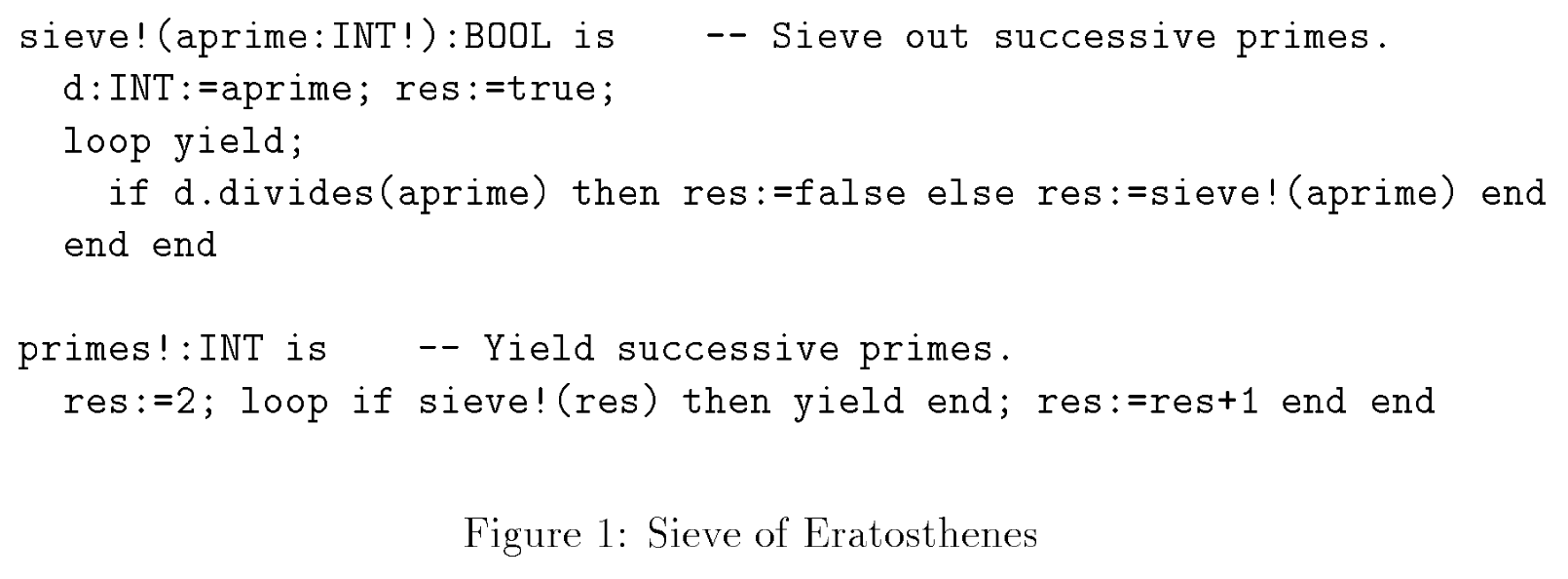The Sather language developed at ICSI had rich language support for iters, object-oriented generic iterators. This paper showed an elegant (though inefficient!) implementation of the Sieve of Eratosthenes that has fascinated me since I was first to the implementation circa 1995. (This great video from Khan Academy explains and visualizes the Sieve of Eratosthenes quite well.)
My goal here was to use the C# iterator idiom as much as possible:
-
yield returnandyield breakto automatically create enumerable collections -
foreachloops instead of manually controlling theIEnumerable<T>methods -
Try for as little code as possible to match the Sather implementation's terseness
This implementation works like this:
-
Initialize the current iterator as an interator that returns successive integers, starting at 2.
-
For each element in the current iterator:
- Yield the current number as a prime.
- Create a new iterator, feeding from the previous iterator, that filters out any integers divisible by the current prime. Set this new iterator as the current iterator. (Note that we only do this until we reach the square root of our limit.)
- Repeat until the current iterator returns a number above our desired limit.
So by the time we hit prime P, we have constructed a filtering iterator for each prime p < P that removes all composites of p. If an integer gets through that chain of filters, it must itself be prime.
(One thing I did note was the Sather implementation didn't stop recursively adding sieves at the square root of n, but kept adding them all the way to the end. I suppose fixing that would have made the example much less elegant, even if more performant.)
Once C# code enters a foreach loop, the compiler asks for an IEnumerator<T> from the thing being iterated. Once the loop has grabbed that enumerator, it cannot be changed. This means if I want to keep adding iterators to the chain, I either have to use a while loop and drive the interface manually or I have to create an IEnumerator<T> class that can change the enumerator on the fly.
At one point in this experiment I had a HotSwappingEnumerator class that did the latter: it was merely a proxy for a changeable IEnumerator<T> reference, passing calls to MoveNext() and Current to it. This allows us to change the current enumerator in the middle of the foreach loop. Awkward, indeed. So I ended up just using a while loop.
This code does make a slight detour from normal C# idiom: instead of the iterator methods returning IEnumerable<T> (typically thought of as being required for using foreach), they return IEnumerator<T>. This allows me to strictly control the creation of iterator state machine objects, the things that look like <Foo>d__0, instead of leaving it to the compiler. When I used the more traditional method in a previous version, the HotSwappingEnumerator class used IEnumerable<T> and ended up having problems because the compiler decided to call GetEnumerator() on the iterators too often, causing a new state machine object to be instantiated, thus causing the iterators to effectively continually reset. By using IEnumerator<T>, I control the allocation of state machine objects by providing my own GetEnumerator()--which just returns this on the current enumerator.
I think I can put this white whale to bed.
